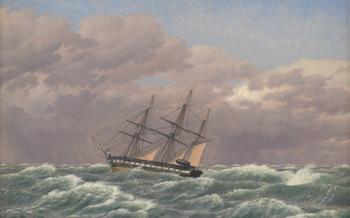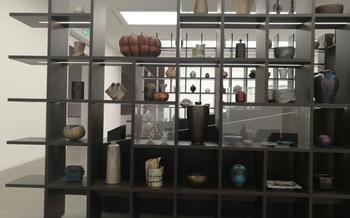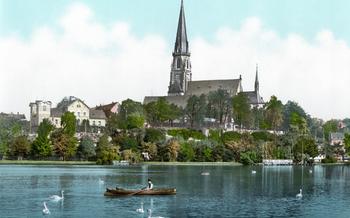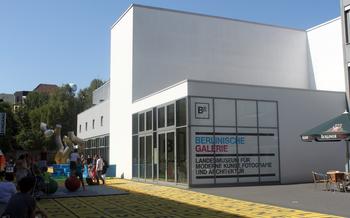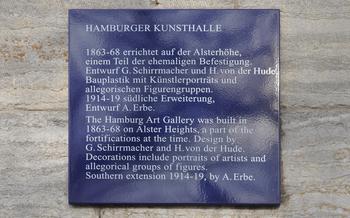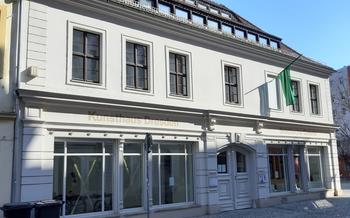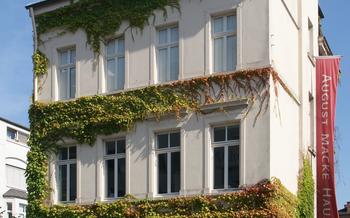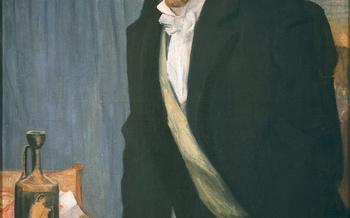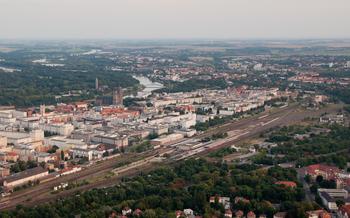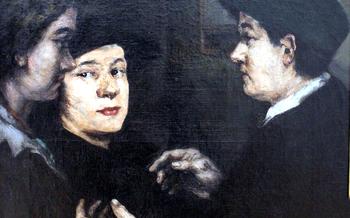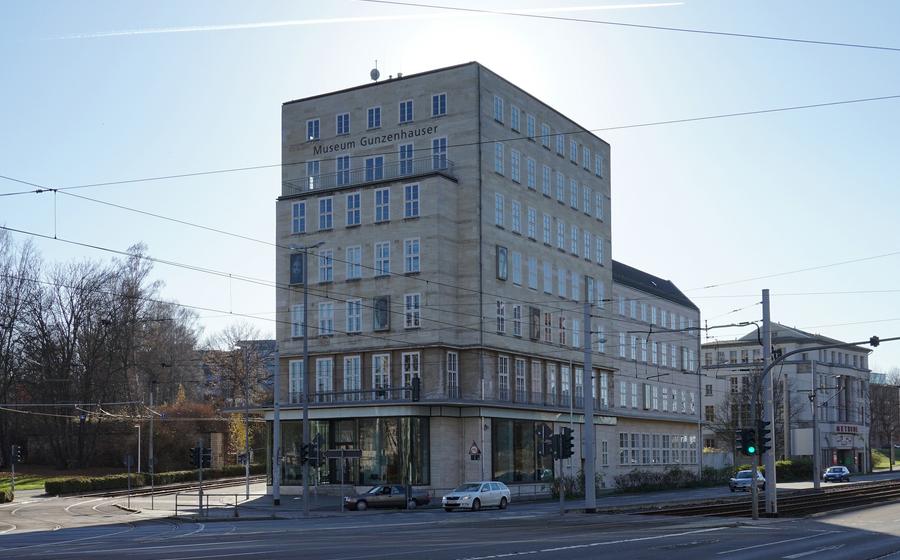
Gunzenhauser Museum
- Gunzenhauser Museum: A Treasure Trove of Modern Art
- Expressionism in Chemnitz
- Karl Schmidt-Rottluff: Master of Expressionism
- Erich Heckel: Expressionist Landscapes
- Emil Nolde: Master of Color and Expression
- Otto Dix: Social Commentary and Realism
- Max Pechstein: Expressionist Seascapes and Portraits
- Museum Tours and Educational Programs
- Temporary Exhibitions and Special Events
- Museum Shop and Café
- Accessibility and Facilities
- Location and Transportation
- Hours of Operation and Admission Fees
- Photography and Social Media
- Insider Tip: Hidden Gem in the Museum
Gunzenhauser Museum: A Treasure Trove of Modern Art
Situated in the heart of Chemnitz, the Gunzenhauser Museum stands as a testament to the city's rich artistic heritage. Founded in 1995, the museum houses an extraordinary collection of Expressionist and Modernist artworks, showcasing the creative genius of some of Germany's most renowned artists.
The museum's collection boasts over 2,500 works of art, including paintings, sculptures, and graphic art. Among the highlights are masterpieces by Karl Schmidt-Rottluff, Erich Heckel, Emil Nolde, Otto Dix, and Max Pechstein, representing the diverse styles and perspectives that shaped the Expressionist movement.
The Gunzenhauser Museum's striking architecture, designed by renowned architect Mario Botta, complements the impressive collection within. The building's modern design, characterized by its cylindrical shape and use of natural light, creates a harmonious dialogue between the artworks and their surroundings.
For art enthusiasts, the Gunzenhauser Museum offers an immersive journey into the world of Expressionism, providing a unique opportunity to witness the evolution of this groundbreaking movement and appreciate the artistic brilliance of its pioneers.
Expressionism in Chemnitz
The Expressionist movement, which emerged in Germany in the early 20th century, was a significant force in the art world. Characterized by its emotional intensity, expressive brushstrokes, and distorted forms, Expressionism sought to convey the inner feelings and subjective experiences of the artist. Chemnitz, a city in eastern Germany, played a pivotal role in the development of Expressionism, becoming a hub for artists who sought to break free from traditional artistic conventions.
The city's industrial heritage and working-class population provided a unique context for Expressionist artists. The harsh realities of industrial life, the social inequalities, and the rapid pace of technological change found their way into the artworks of Chemnitz-based Expressionists. They used their art to critique society, express their emotions, and explore the human condition in a rapidly changing world.
One of the most prominent Expressionist groups in Chemnitz was Die Brücke (The Bridge), founded in 1905 by Erich Heckel, Karl Schmidt-Rottluff, and Ernst Ludwig Kirchner. Die Brücke artists rejected the prevailing academic and Impressionist styles, seeking to create a new, more authentic form of art that reflected their inner experiences. They experimented with bold colors, simplified forms, and emotional content, producing artworks that were both visually striking and deeply personal.
Chemnitz's Expressionist legacy is proudly showcased at the Gunzenhauser Museum, which houses a significant collection of works by Die Brücke artists and other prominent Expressionists. Visitors can explore the diverse range of Expressionist styles, from the vibrant colors and dynamic brushstrokes of Heckel to the more introspective and melancholic works of Schmidt-Rottluff. The museum provides a comprehensive overview of Expressionism in Chemnitz, allowing visitors to delve into the history, influences, and artistic achievements of this important movement.
Karl Schmidt-Rottluff: Master of Expressionism
Karl Schmidt-Rottluff, a prominent figure in the Expressionist movement, played a pivotal role in shaping the course of modern art. Born in Rottluff, Germany, in 1884, he was one of the founding members of Die Brücke (The Bridge), a group of Expressionist artists who sought to challenge traditional artistic conventions and push the boundaries of artistic expression.
Schmidt-Rottluff's artistic style was characterized by bold colors, simplified forms, and a strong emotional intensity. He often depicted scenes of everyday life, using vibrant hues and exaggerated forms to convey the inner feelings and emotions of his subjects. His works often explored themes of alienation, isolation, and the human condition in a rapidly changing world.
One of Schmidt-Rottluff's most notable works, "Self-Portrait with Monocle" (1910), showcases his distinctive style. The painting features a close-up view of the artist, with his piercing blue eyes staring directly at the viewer. The use of bold colors and exaggerated features conveys a sense of intensity and introspection, inviting viewers to contemplate the artist's inner world.
Schmidt-Rottluff's legacy in the art world is significant. His bold and expressive style helped to define the Expressionist movement, and his works continue to inspire and captivate audiences worldwide. The Gunzenhauser Museum in Chemnitz houses a significant collection of Schmidt-Rottluff's paintings, drawings, and prints, offering visitors a unique opportunity to explore the artistic journey of this influential Expressionist master.
Erich Heckel: Expressionist Landscapes
Erich Heckel, another prominent Expressionist artist, is well-represented at the Gunzenhauser Museum. His landscapes, often depicting the surroundings of Chemnitz, capture the essence of the city's industrial heritage. Through vibrant colors and dynamic brushstrokes, Heckel conveyed the emotional intensity of the urban environment.
One of Heckel's most notable works on display is "Chemnitz Landscape," painted in 19The painting portrays a panoramic view of the city, with its factories and chimneys emitting smoke into the sky. Heckel's use of bold colors and simplified forms creates a sense of energy and movement, reflecting the industrial transformation of Chemnitz at the time.
Another highlight is "Winter Landscape," painted in 19In this work, Heckel depicts a snowy scene with a lone tree in the foreground. The stark contrast between the white snow and the dark tree branches conveys a sense of isolation and melancholy, capturing the emotional undertones of the Expressionist movement.
Heckel's landscapes offer a unique perspective on the city of Chemnitz, showcasing its industrial character and the emotional experiences of its inhabitants. His artworks at the Gunzenhauser Museum provide visitors with a glimpse into the vibrant Expressionist movement and its profound impact on German art.
Emil Nolde: Master of Color and Expression
Among the Expressionist masters showcased at the Gunzenhauser Museum, Emil Nolde stands out for his vibrant use of colors and emotional intensity. Born in 1867 in Schleswig, Nolde's artistic journey took him from early Impressionist influences to the bold and expressive style that would define his career.
His paintings are characterized by a unique blend of realism and abstraction, where colors become the primary vehicle for conveying emotions and inner experiences. Nolde's landscapes, seascapes, and religious scenes burst with saturated hues, creating a sense of dynamism and energy that captivates viewers.
Despite his artistic prowess, Nolde's life was marked by controversy and political turmoil. His support for the Nazi regime during the early years led to a complex relationship with the art world. While his membership in the Nazi party was eventually revoked, his legacy remains tainted by his association with the regime.
Nevertheless, Nolde's artistic contributions cannot be overlooked. His bold and expressive style, combined with his mastery of color, earned him a place among the most prominent Expressionist artists of his time. The Gunzenhauser Museum houses a significant collection of Nolde's works, offering visitors a chance to explore the depths of his emotional and colorful universe.
Otto Dix: Social Commentary and Realism
Otto Dix, a prominent artist associated with the Neue Sachlichkeit (New Objectivity) movement, left an indelible mark on the art world through his poignant social commentary and unflinching depictions of society's darker realities. His artworks, often characterized by a sense of disillusionment and criticism, confronted viewers with the harsh truths of war, poverty, and social injustice.
At the Gunzenhauser Museum, visitors can delve into Dix's powerful body of work, which includes paintings, prints, and drawings that offer a glimpse into the tumultuous social and political landscape of Germany during the early 20th century. Among his notable works on display is "Trench Warfare," a haunting portrayal of the horrors of World War I, where faceless soldiers are depicted as mere cogs in a machine of destruction.
Dix's commitment to social realism is also evident in his series of triptychs, such as "War" and "Metropolis," which provide a scathing critique of the dehumanizing effects of modern society. Through his art, Dix aimed to provoke viewers, challenge societal norms, and expose the underlying tensions and contradictions of his time. His works continue to resonate with audiences today, serving as a reminder of the power of art to confront and challenge social injustices.
Max Pechstein: Expressionist Seascapes and Portraits
Max Pechstein, a prominent figure in the Expressionist movement, left an indelible mark on the art world with his vibrant colors and bold brushstrokes. Born in Zwickau, Germany, in 1881, Pechstein's artistic journey took him to the heart of Expressionism, where he became a founding member of the Brücke group.
Pechstein's works are characterized by their intensity and emotional depth. His seascapes, a recurring theme in his paintings, capture the raw power and vastness of the ocean. The crashing waves, the shifting colors of the sky, and the interplay of light and shadow are rendered with a unique energy that draws viewers into the heart of the marine world.
In addition to his seascapes, Pechstein was also renowned for his portraits. His subjects, often depicted with elongated features and exaggerated expressions, reveal a deep understanding of human emotions and psychology. The use of bold colors and simplified forms enhances the emotional impact of his portraits, creating a sense of intimacy and connection with the viewer.
At the Gunzenhauser Museum, visitors can admire several notable works by Max Pechstein. Among them are "Seascape with Red Sky" (1910), a vibrant depiction of the sea under a fiery sunset, and "Portrait of a Woman" (1912), which captures the essence of his unique style with its intense colors and expressive brushwork. These masterpieces showcase Pechstein's mastery of Expressionism and his significant contribution to the movement.
Museum Tours and Educational Programs
The Gunzenhauser Museum offers guided tours that delve into the history, significance, and artistic techniques showcased in its collection. Knowledgeable guides provide insights into the lives and works of the featured Expressionist masters, shedding light on their inspirations, styles, and impact on the art world. Visitors can choose from various tour options, including general introductions, thematic explorations, and in-depth analyses of specific artworks.
Additionally, the museum organizes educational programs and workshops designed to engage visitors of all ages with modern art. These programs include hands-on art activities, creative workshops, and lectures by experts in the field. Children and families can participate in interactive sessions that foster artistic expression and appreciation. The museum's educational initiatives aim to inspire, educate, and create a deeper understanding of the artistic movements and techniques represented in its collection.
Advance booking for guided tours and educational programs is recommended to secure your spot and avoid disappointment. Visitors can check the museum's website for tour schedules, availability, and booking options. Whether you're an art enthusiast, a history buff, or simply seeking a creative and educational experience, the Gunzenhauser Museum's tours and programs offer a rewarding and immersive journey into the world of Expressionism.
Temporary Exhibitions and Special Events
The Gunzenhauser Museum not only houses a permanent collection but also hosts a variety of temporary exhibitions throughout the year. These exhibitions showcase diverse art forms, ranging from contemporary installations to historical retrospectives, and offer visitors a chance to explore new perspectives and artistic expressions.
Special events, workshops, and lectures are regularly organized by the museum to engage visitors with the world of art. These events provide opportunities for in-depth learning and discussions about the museum's collection, as well as contemporary art trends and practices.
Visitors can check the museum's website or social media platforms for advance information on upcoming exhibitions and events. This allows them to plan their visit accordingly and make the most of their time at the Gunzenhauser Museum.
Whether you're an art enthusiast, a history buff, or simply looking for a unique and enriching experience, the Gunzenhauser Museum offers a dynamic and engaging environment that caters to diverse interests.
Museum Shop and Café
The Gunzenhauser Museum offers a well-stocked museum shop where art enthusiasts can purchase a variety of souvenirs to commemorate their visit. From postcards and posters featuring the museum's highlights to art books and catalogs showcasing the works of featured artists, the shop provides a range of options for visitors to take a piece of the museum experience home with them.
For those seeking refreshments, the museum café is an inviting space to relax and recharge. Visitors can enjoy a variety of beverages, including specialty coffees and teas, as well as a selection of light snacks and pastries. The café's menu also features seasonal specials inspired by the artworks on display, offering a unique culinary experience that combines art and taste. The café's cozy atmosphere, with its comfortable seating and panoramic views of the museum's surroundings, makes it an ideal spot to take a break from exploring the galleries and immerse oneself in the creative ambiance.
Whether browsing for souvenirs or savoring a moment of relaxation, the museum shop and café at the Gunzenhauser Museum enhance the visitor experience by providing opportunities to engage with art beyond the galleries and create lasting memories of a visit to this cultural gem in Chemnitz.
Accessibility and Facilities
The Gunzenhauser Museum is committed to providing an accessible and inclusive environment for all visitors. Wheelchair access, ramps, and elevators are available throughout the museum, ensuring that visitors with disabilities can comfortably navigate the exhibition spaces. Additionally, the museum offers a variety of services for visitors with special needs, including guided tours in sign language and audio descriptions for visually impaired visitors. Restrooms, lockers, and cloakrooms are conveniently located for the convenience of all visitors. Whether you have specific accessibility requirements or simply need a place to store your belongings, the Gunzenhauser Museum has you covered.
Location and Transportation
Finding Your Way to the Gunzenhauser Museum:
The Gunzenhauser Museum is conveniently located in the heart of Chemnitz, making it easily accessible by various means of transportation. To reach the museum, head to Theaterplatz 1, 09111 Chemnitz, Germany.
Public Transportation:
Chemnitz boasts an efficient public transportation system that connects the city's neighborhoods seamlessly. Visitors can hop on bus routes 31, 32, 33, 35, 62, or 92 to reach the museum stop, "Stadthalle." Alternatively, tram lines 2, 3, 4, and 5 also have stops near the museum at "Stadthalle" or "Theaterplatz."
Driving and Parking:
For those arriving by car, the museum offers ample parking options nearby. The "Stadthalle" parking garage, located just a short walk from the museum, provides secure and convenient parking spaces. Additional street parking is available on Theaterplatz and the surrounding streets.
Exploring Chemnitz:
Once you've parked your car or stepped off the tram, take a moment to explore the vibrant city of Chemnitz. The Gunzenhauser Museum is situated in the city center, surrounded by historical landmarks, shopping streets, and charming cafes. Take a leisurely stroll, soak in the local atmosphere, and discover the many attractions Chemnitz offers.
Hours of Operation and Admission Fees
The Gunzenhauser Museum welcomes visitors from Tuesday to Sunday, with slightly varied hours each day. It remains closed on Mondays. Regular opening hours are from 11 am to 5 pm on weekdays (Tuesday to Friday) and from 11 am to 6 pm on weekends (Saturday and Sunday).
Admission fees are reasonable, allowing visitors to access the museum's impressive collection. Adults can purchase a standard ticket for €6, while concessions such as students and seniors can enjoy a reduced rate of €Families can take advantage of a special family ticket priced at €12, making it an affordable option for a day out with loved ones.
The museum also offers discounted rates for groups of 10 or more visitors. To inquire about group discounts and make advance bookings, visitors can contact the museum directly through the provided email address or phone number. Advance ticket purchase is recommended to ensure a seamless and hassle-free visit, especially during peak tourist seasons or for special exhibitions.
Photography and Social Media
The Gunzenhauser Museum encourages visitors to capture and share their experiences through photography. While flash photography is not permitted to protect the artworks, visitors are welcome to take photos for personal use. The museum embraces the power of social media as a platform for art appreciation and engagement. Visitors are encouraged to share their photos, impressions, and insights on social media using the official hashtags and tagging the museum's handles. This creates a vibrant online community where visitors can connect, share their perspectives, and engage in discussions about the museum's collection. By sharing their experiences, visitors become part of a larger conversation about modern art and contribute to the museum's mission of promoting art appreciation and education.
Insider Tip: Hidden Gem in the Museum
Beyond the renowned masterpieces, the Gunzenhauser Museum holds a hidden gem that often goes unnoticed by visitors. Tucked away in a quiet corner of the museum, you'll find a small, unassuming painting that packs a powerful punch. It's a landscape by Karl Schmidt-Rottluff, titled "Winter in Chemnitz." The painting depicts a desolate urban scene, with snow-covered rooftops and leafless trees against a gloomy sky. The muted colors and stark composition convey a sense of isolation and melancholy that is both haunting and beautiful.
It's easy to overlook this painting amidst the more famous works in the museum, but it's worth taking a moment to seek it out. The painting offers a glimpse into Schmidt-Rottluff's early artistic style and his ability to capture the essence of a city through his unique Expressionist lens. Its emotional depth and subtle beauty make it a hidden treasure waiting to be discovered by visitors who venture beyond the obvious highlights.
